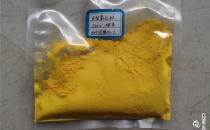Nano-
bismuth oxide Bi2O3 (VK-Bi50) is an important functional material. Nano-bismuth oxide (VK-Bi50) is widely used. It is not only a good organic synthesis catalyst, ceramic colorant, plastic flame retardant, medicinal Astringent, glass additive, high refractive glass and nuclear engineering glass manufacturing and nuclear reactor fuel, and is an important doped powder material in the electronics industry.
1. Electronic functional materials
Nano-bismuth oxide powder (VK-Bi50) as an electronic functional powder doping material is widely used in the production of sensitive components, dielectric ceramics and other electronic components. It has the characteristics of high quality requirements, small quantity and wide range. . Under normal conditions, monoclinic Α2Bi2O3 is stable, and its crystal structure contains a large number of oxygen vacancies, and oxygen ions have good conductivity, and can be used to make various solid oxide fuel cells and oxygen sensors. Nano-bismuth oxide (VK-Bi50) is also an active material commonly used in chemical power sources, such as an excellent corrosion inhibitor for mercury-free zinc batteries, an electrode material for lithium batteries, and an additive to improve the rechargeability of alkaline Zn ƒM nO2 batteries. The study found that the rechargeable performance of nano-scale bismuth oxide (VK-Bi50) is better than that of conventional bismuth oxide powder, and as an additive to the positive electrode active material EMD of a primary battery, it shows excellent performance under deep discharge.
2. Burning rate catalyst
Lead oxide is an important burning rate catalyst in double-base solid propellants. It can increase the burning rate of the propellant and reduce the pressure index. However, lead is highly toxic and has direct or potential harm to people or the environment. Bismuth compound is a burning rate catalyst with low toxicity, less smoke, and extremely safe for ecology. Experiments have proved that nano-Bi2O3 (VK-Bi50) improves the propellant burning rate in the low-pressure section better than nano-PbO, and has the effect of reducing the propellant pressure index. Therefore, nano-bismuth oxide (VK-Bi50) has the potential to replace nano-lead oxide bright future.

3. Photocatalytic degradation materials
In recent years, the use of semiconductor photocatalytic degradation of harmful pollutants has become one of the more popular research topics, because it can effectively use solar energy and generate strong oxidizing holes and hydroxyl radicals in the reaction, so it has attracted people's attention . At present, TiO 2 with high photocatalytic activity and good stability is widely used, but because of its wide band gap (3. 2eV), it can only absorb ultraviolet light with a wavelength of Κ≤387 nm. In recent years, it has been reported to use Bi2O3 photocatalytic treatment of wastewater containing nitrite experimental research, the results show that Bi2O3 has better photocatalytic activity. Due to the large specific surface area, many surface active points, and high photocatalytic activity, nanomaterials show more excellent photocatalytic properties. Although the research on the photocatalytic activity of nano-Bi2O3 has not been reported, it can be predicted that nano-Bi2O3 (VK-Bi50) has better photocatalytic performance than ordinary powder.
4. Optical materials
Nano
bismuth oxide (VK-Bi50) is an inorganic oxide material with large non-resonant third-order nonlinear susceptibility. Studies have shown that at the nanoscale, the optical nonlinear response of materials increases. When the surface coating of nanomaterials is carried out, the nonlinear response is further increased. According to literature reports, the nano-particles of bismuth oxide coated with sodium dodecylbenzenesulfonate have a large trivalent nonlinear optical coefficient, even under weak light, and have a large nonlinear coefficient. Such characteristics It is of great significance to the development of nonlinear optical devices.
5. Anti-radiation materials
Current radiation protection materials are generally lead-containing products, and lead is harmful to both the human body and the environment. Bismuth is a "green metal", and the ray attenuation coefficient of bismuth is larger than that of lead. If the strong anti-radiation performance of nano-bismuth oxide (VK-Bi50) is combined with the quantum effect of nano-materials, it will be beneficial to the development of High-performance anti-radiation materials are undoubtedly a new way.
Nano
bismuth oxide technical indicators:
Technical indicators:
Model VK-Bi50 VK-Bi80
Appearance yellow powder yellow powder
Purity % 99.9 99.9
Particle size nm 50 80
Specific table m2/g 40-50 35-45

